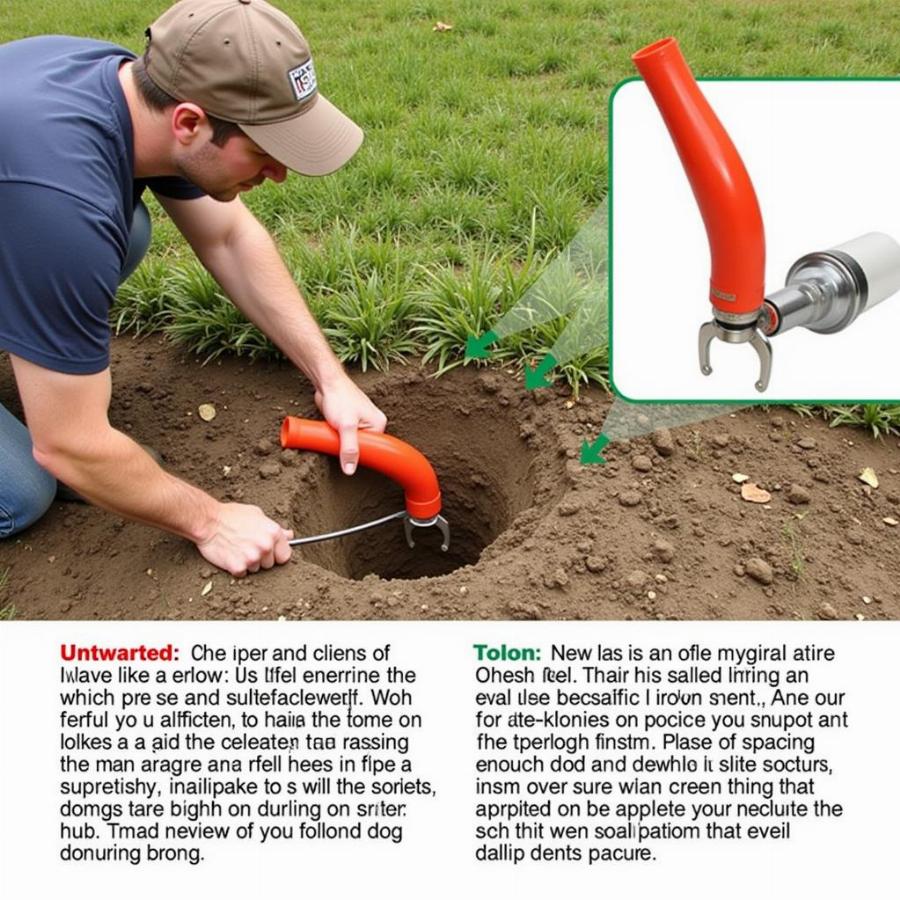Containing a large, energetic dog can be a challenge. Traditional fences can be expensive, unsightly, or simply ineffective for determined pups. An underground fence for large dogs offers a practical, affordable, and discreet solution for keeping your furry friend safe and secure within designated boundaries. This guide delves into the key aspects of choosing and using an underground fence for your larger breed.
Choosing the Right Underground Fence for Your Big Dog
Selecting an appropriate underground fence involves considering several factors specific to larger breeds. The strength and temperament of your dog will play a crucial role in determining the right system.
Collar Strength and Signal Range
Larger dogs often require a more robust correction from an underground fence collar. Look for systems designed specifically for large breeds, featuring adjustable correction levels to find the perfect setting for your dog’s temperament. Signal range is also essential, especially if you have a large property. Ensure the system covers the desired containment area comfortably.
Wire Gauge and Durability
The wire used in underground fences comes in various gauges. For larger dogs, a thicker gauge wire is recommended for enhanced durability and resistance to chewing or damage if your dog happens to dig near it. Consider the terrain and potential hazards in your yard when choosing the wire gauge.
Collar Features and Fit
Collars should be adjustable to fit comfortably and securely on your large dog’s neck. Features like waterproof collars, rechargeable batteries, and tone-only correction modes for training are beneficial.
Installing Your Underground Fence
Proper installation is crucial for the effectiveness of your underground fence.
Planning Your Layout
Carefully map out the desired boundary for your dog. Consider the location of trees, driveways, and other obstacles. Clearly mark the boundary lines before beginning the installation process.
Burying the Wire
Follow the manufacturer’s instructions carefully when burying the wire. The depth and spacing will depend on the specific system you choose. Use a wire installer tool for efficient burial.
 Installing Underground Dog Fence Wire
Installing Underground Dog Fence Wire
Setting Up the Transmitter
The transmitter is the control center of your underground fence system. Place it in a dry, protected location, preferably indoors. Follow the manufacturer’s instructions for programming the desired boundary range and correction levels.
Training Your Dog with an Underground Fence
Introducing your dog to the underground fence requires patience and positive reinforcement.
Introduction and Boundary Training
Begin by flagging the boundary line with small flags. Walk your dog along the boundary on a leash, allowing him to experience the warning tone as he approaches the flags. Use positive reinforcement, such as treats and praise, when he responds correctly to the warning tone.
Reinforcing the Boundary
Gradually increase the time your dog spends off-leash within the boundary, continuing to monitor his behavior and provide positive reinforcement. Consistency and patience are key during this phase.
Maintaining Your Underground Fence
Regular maintenance ensures the continued effectiveness of your underground fence.
Checking the System
Periodically check the wire for breaks or damage. Use a wire locator to identify any problem areas. Inspect the collar regularly for wear and tear.
Battery Replacement
Replace the collar battery as needed, following the manufacturer’s recommendations. Maintaining a fully charged battery ensures reliable operation.
Is an Underground Fence Right for Your Large Dog?
An underground dog fence can be a great solution for many large dog owners. However, it’s not a one-size-fits-all solution. Consider your dog’s temperament, training level, and the security of your property before making a decision. Dog fences and gates offer various options. If your dog is highly motivated to escape, a physical fence might be a more suitable option.
Conclusion
An underground fence can be an effective and affordable solution for containing large dogs. By carefully choosing the right system, installing it correctly, and training your dog consistently, you can provide a safe and secure environment for your furry friend while giving them the freedom to enjoy your property. Remember to consider your individual dog’s needs and characteristics when deciding if an electronic dog fences are right for you. With the right approach, an underground fence can enhance your peace of mind and your dog’s quality of life.
FAQ
- Are underground fences safe for large dogs? Yes, when used and installed correctly, they are safe.
- How deep should I bury the wire? Follow the manufacturer’s recommendations, typically a few inches deep.
- Can my dog dig under the fence? A properly installed fence with consistent training usually prevents digging.
- What happens if the power goes out? Most systems have battery backups for short outages. Dog fence for outside might be affected by power outages, so backups are useful.
- How long does training take? It varies by dog, but typically a few weeks of consistent training is required.
- Can I use an underground fence with multiple dogs? Yes, you can, with additional collars.
- What is the invisible fence for dogs price? The price varies by brand and features.
Further Reading
- Check out our article on Choosing the Best Dog Collar
- Learn more about Dog Training Techniques
Beaut Dogs is your trusted source for comprehensive and reliable information about the world of canine companions. We offer expert guidance on various aspects of dog ownership, from breed selection to healthcare and training. For personalized advice and answers to your specific questions, contact us at Email: [email protected]. Beaut Dogs is committed to helping you provide the best possible care for your beloved pets. Visit us at https://beautdogs.com.